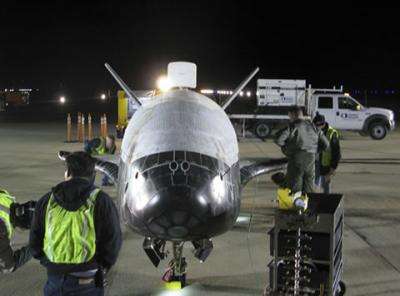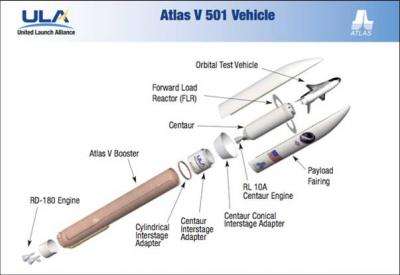Air Force and ULA to launch second X-37B

From all appearances the first flight of the U.S. Air Force’s secretive X-37B space plane was a complete success. As such, the Air Force is planning to launch a second Orbital Test Vehicle (OTV) on March 4 from Cape Canaveral Air Force Station in Florida on top of a United Launch Alliance (ULA) Atlas rocket. The Air Force has not yet released a specific launch time.
The first flight of an OTV took place on Apr. 22, 2010 on top of an Atlas V 501 rocket and was designated USA-212. Built by Boeing, the spacecraft is unmanned and is in many ways similar to the space shuttle. It has a payload bay, maneuvering thrusters up front and to the rear of the spacecraft and a single, primary engine.
The OTV is different from the space shuttle in that it can operate on-orbit for up to 270 days. During the vehicle’s maiden flight it was spotted by a number of amateur astronomers who verified that the craft changed orbits a number of times before it landed safely at Vandenberg Air Force base on Dec. 3, 2010.
“We are tremendously excited to launch the second OTV space vehicle for the Air Force Rapid Capabilities Office. Our combined Air Force and ULA mission partner team has worked hard to prepare the Atlas V for this mission which is the first launch of the year for ULA from the east coast in 2011,” said ULA’s Director of Communications, Mike Rein. “I fully expect this launch to be a 100 percent successful mission – just like the first OTV launch in April 2010.”

Originally the OTV was to be deployed from the space shuttle’s payload bay, after the Columbia accident however, it was decided to launch from an EELV instead. At first a Delta II was given the nod to launch the space plane – before the Atlas V was confirmed as the launch vehicle that would be used.
The U.S. Air Force has disclosed only minimal information regarding the first mission and has said little about the upcoming mission as well. The Air Force has stated that the length of the OTV’s mission’s will be determined by the completion rates of the experiments that are onboard. Mission control is based out of Colorado with the 3d Space Experimentation Squadron.
The X-37B is only the second reusable spacecraft that is capable of conducting an automated landing. The only other reusable craft that has demonstrated this capability was Russia’s Buran shuttle which returned safely to Earth on Nov. 15, 1988.
The X-37B was a program initially handled by NASA; however the program was eventually turned over to the U.S. Defense Advanced Research Projects Agency (DARPA) and the Pentagon. The OTV flew several times on Scaled Composites’ White Knight aircraft and was drop tested twice successfully in 2006.
Source: Universe Today

















